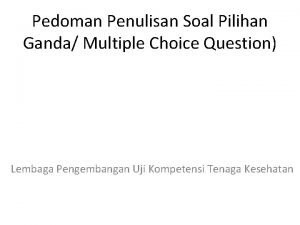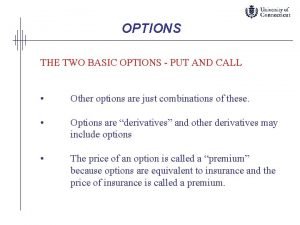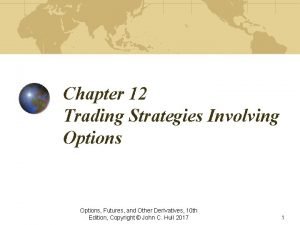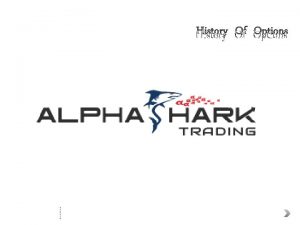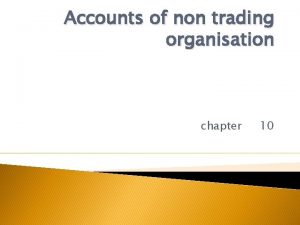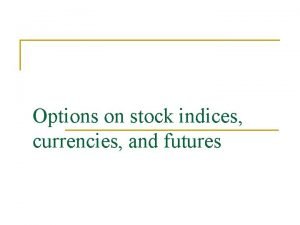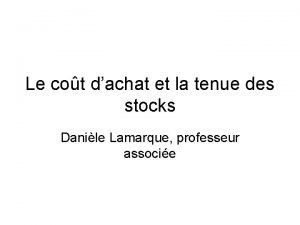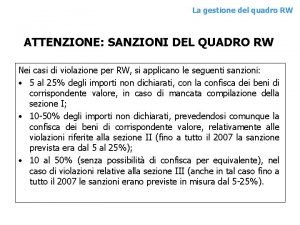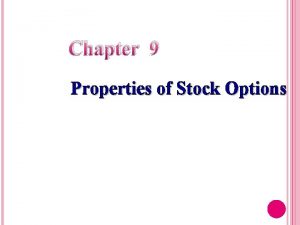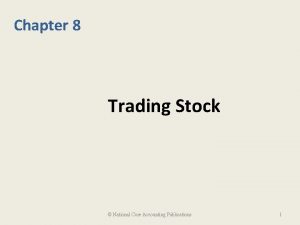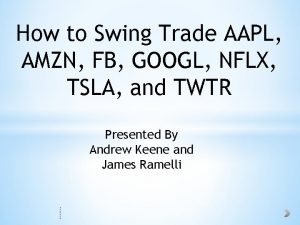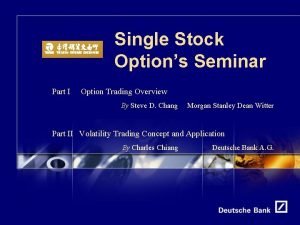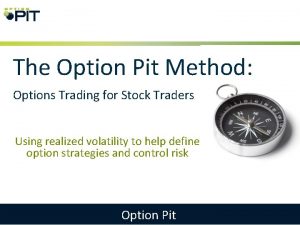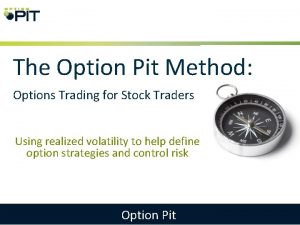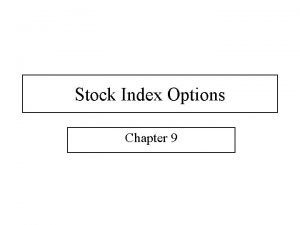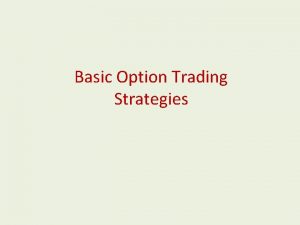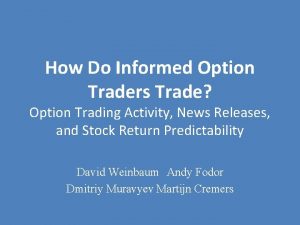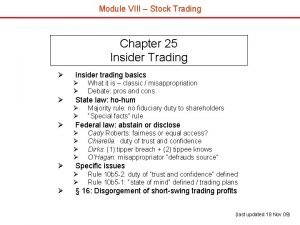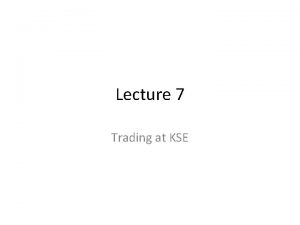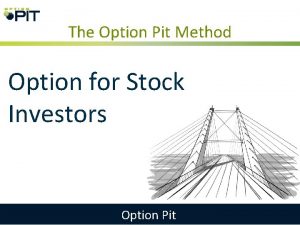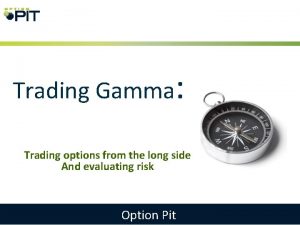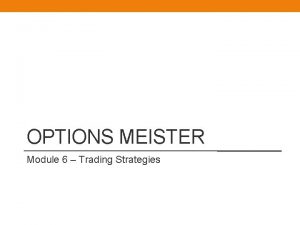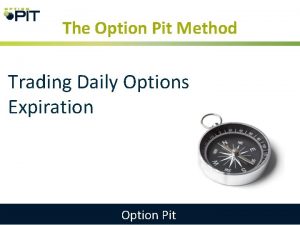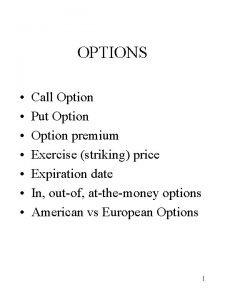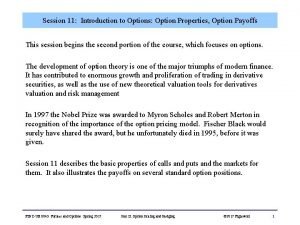Single Stock Options Seminar Part I Option Trading




























- Slides: 28

Single Stock Option’s Seminar Part I Option Trading Overview By Steve D. Chang Morgan Stanley Dean Witter Part II Volatility Trading Concept and Application By Charles Chiang Deutsche Bank A. G. 1

Options Trading Overview By Steve Chang 2

Introduction n Steve Chang Equity Derivatives Trader at Morgan Stanley 3

Topics of Discussion n Basic on Options n Overview on Greeks n Volatility n Why using options? n Impact to TSE n Trading Strategies n Buy/Sell Greeks n Scenario analysis n Q&A 4

Basics on Options n n Call – give the holder the right to buy the stock by a certain date for certain price Put – give the holder the right to sell the stock by a certain date for certain price Premium - cost of options (call or put) Strike price - the price at which an option contract gives the holder the right to buy/sell 5

Basics on Options n Expiration date - final date options can be exercised n Volatility – risk factor of an option that determines the premium (40 vol = 2. 5% intraday gap) n American options - options can be exercised before expiry n European options - options can only be exercised at expiry 6

Overview on Greeks n n Delta – rate of change of option’s price w/ change in underlying asset, usually short dated ATM call/put has ~0. 5 delta Gamma - rate of change of delta w/ the change in underlying asset, usually quoted in % term (+$1 mn gamma, mkt +3%, +$3 mn delta) 7

Overview on Greeks n n n Kappa (vega) - rate of change of option’s price with change in volatility. Theta – rate of change of option’s price with change in time, the price of gamma/kappa Rho – rate of change of option’s price with change in interest rate 8

Volatility n Higher the vol, higher the premium 2 mth 100% call at 40% vol ~ 6. 75% (0 div, 1. 82% Rfr) u 2 mth 100% call at 70% vol ~ 11. 65% u n Market implied vol vs. asset vol Implied usually higher than asset (Hang Seng, S&P) u Implied vol at 40% -> 2. 5% gap risk u 9

Volatility – 2330 10

Volatility – 1310 11

Volatility – 2882 12

Why using Options? n n n Leverage/ gearing effect (like warrants) Reinforce stop-loss concept when buying Income enhance when selling Portfolio hedge for PMs Short access to single stock names (+P, -C) Long access to single stock w/o showing broker identity 13

Impact to TSE n n n More participation from retails investors Enhance market liquidity with delta hedge Stock lending system needs to be developed Stock lending can increase market liquidity thru long/short pair trading Limit-up/limit-down 7% structure 14

Trading Strategies n n n n Buy downside put as insurance when long stocks Sell upside call to collect premium when upside is limited Buy call spread expecting limited upside Buy put spread expecting limited downside Buy strangle or straddle expecting volatility ahead Synthetic short – buy put sell call Most PMs buy options not sell 15

Trading Strategies Buy call option u Expecting more upside 16

Trading Strategies Sell put option n Expecting limited downside 17

Trading Strategies Buy call spread n When? u n For Example: u n n n Expecting more upside, reduce prem by giving up some upside you buy 100/120 call spread – buy 100% call, sell 120% call Max upside = 120 – 100 – prem(%) Max downside = premium you paid Sell call spread – vice versa 18

Trading Strategies Buy put spread n When? u Expecting more down, reduce premium by giving up some downside protection For example: u Buy 100/90 put spread – buy 100% put, sell 90% put Max upside = 100 – 90 – prem(%) Max downside = prem you paid n Sell put spread – vice versa n n n 19

Trading Strategies Buy Straddle n n n n Buy both ATM call and put Max gain: unlimited Max loss: time decay (theta) Buy gamma and kappa, pay theta Short dated straddle – buy more gamma Long dated straddle – buy more kappa Sell straddle – vice versa 20

Trading Strategies Buy strangle n n n n Buy both OTM call and put Max gain: unlimited Max loss: time decay, theta You buy gamma and kappa, earn theta Short dated strangle – buy more gamma Long dated strangle – buy more kappa Diversify your risk comparing to straddle and cheaper Long straddle – vice versa 21

Buy/sell Greeks n n Buy delta u Buy spot (ie, future or stocks) u Buy call u Sell put Sell delta – vice versa 22

Buy/sell Greeks n n Buy gamma u Buy call or put u Short dated options give you more gamma u ATM options give you more gamma Sell gamma – vice versa 23

Buy/sell Greeks n n Buy Kappa u Buy call or put u Long dated options give you more kappa u ATM options give you more kappa Sell kappa – vice versa 24

Buy/sell Greeks n Long theta (receive time decay) Sell call or put u Short dated options give you more theta (in the expense of short more gamma) u ATM options give you more theta u n n Sell theta – vice versa Buy/sell Rho – N/A for Taiwan, usually hedged by eurodollar futures or swaps 25

Scenario Analysis n n n If you have $1 mn to buy a stock ($100). Option vs. stock strategy? (assume no funding cost) Buy 10 k at $100, +30% after 2 mth, Pn. L = $300 k If you buy 10 k of 2 mth $100 strike call paying 7% or $70 k (40%vol) If stock +30% in 2 mth, then you have the right to buy 10 k shares at $100 which will give you the Pn. L of $230 k ($300 k – $70 k) …also less funding. Max loss using option is $70 k, but loss is unlimited buying stocks If you spend $1 mn on option, Pn. L = $3. 3 mn = $1 mn/7%*(30%-7%) 26

Scenario Analysis n n n If you are long $2 mn gamma on a stock, then stocks – 28% thru 4 days of limit-down…what would be your payout? $2 mn*28 = 56 mn you are short US$28 mn which you may cover @28% discount. Pn. L impact: 28 mn/2*28%=$7. 84 mn 27

Q&A 28
 Soal pilihan ganda (multiple choice)
Soal pilihan ganda (multiple choice) Stock options terminology
Stock options terminology Option investing strategies
Option investing strategies What are options trading
What are options trading Trading strategies involving options
Trading strategies involving options Ichimoku
Ichimoku History of options
History of options Accounting for non trading organisation
Accounting for non trading organisation Bagaimana cara pencatatan pembatalan untuk stock option
Bagaimana cara pencatatan pembatalan untuk stock option Put call parity formula
Put call parity formula Stock option
Stock option Stock option quadro rw
Stock option quadro rw Gigaplex academy
Gigaplex academy Properties of stock options
Properties of stock options How the stock market works.com
How the stock market works.com Trading account general ledger
Trading account general ledger Accounting for trading stock
Accounting for trading stock Classroom stock market game
Classroom stock market game Swing trading amazon stock
Swing trading amazon stock Single touch payroll seminar
Single touch payroll seminar Features of preferred stock
Features of preferred stock White stock yang sesuai dengan kriteria yaitu
White stock yang sesuai dengan kriteria yaitu Characteristics of corporate bonds and stocks
Characteristics of corporate bonds and stocks Stock initial
Stock initial Ap seminar part b outline
Ap seminar part b outline Single stock dividend futures
Single stock dividend futures Sisd in computer architecture
Sisd in computer architecture Single instruction single data
Single instruction single data Multi channel multi phase example
Multi channel multi phase example
